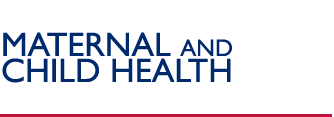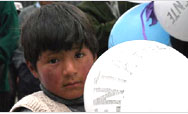Polio Eradication Initiative: Interventions and Achievements
Partnerships
Diplomatic outreach. With strong USAID involvement, the United States led a diplomatic effort to encourage and promote the involvement of Muslim countries and organizations in polio eradication, as the vast majority of affected children are Muslims living in Africa and Asia. As a result, Saudi Arabia, Turkey, and the Bill & Melinda Gates Foundation responded with new funds for the global polio eradication effort. A series of communiqués to USAID Missions and U.S. Embassies heightened the awareness at U.S. diplomatic posts on the need for increased funding, high-quality immunizations, and case reporting across the globe. In Indonesia, USAID helped secure government commitment for introducing monovalent type 1 vaccine, which offers high protection with fewer doses for the dominant local virus type than the traditional trivalent vaccine.
National commitments. USAID funds supported the Synchronized Pan-African Immunization Campaign Against Poliomyelitis, which was launched in 2005 in 23 countries of Central and West Africa. USAID supported WHO and remaining polioendemic countries such as Nigeria and Afghanistan in renewing their commitment to end poliovirus transmission through intensified immunization campaigns.
Community-based networks. USAID remains the only donor funding NGOs for systematic work in polio eradication. The USAID-funded CORE Group Polio Project links U.S.-based PVOs and local community-based organizations to increase immunization acceptance and to carry out polio immunizations, communications, and case detection in the poorest and most challenging areas. In India, CORE partners worked through its network of 1,500 community mobilizers, religious leaders, and influential citizens to build confidence in the immunization program and thus reduce the number of families refusing vaccines. In one district, the number of resistant households decreased from more than 50 to just three. CORE partners in Ethiopia moved their focus to borders with other countries to reduce the spread of virus throughout the Horn of Africa. In Angola, the CORE Secretariat used Geographic Assessment of Planning and Services (GAPS) methodology to monitor the quality of immunization campaigns, which helped organizers correct gaps in coverage and vaccination techniques while the campaigns were ongoing. In Nepal, CORE deployed its network to strengthen immunizations along the border with India after cases were reported. A CORE NGO conducted a one-day orientation meeting for 199 community volunteers to discuss a campaign for repeating doses of oral polio drops and the volunteers' roles in mobilizing families to bring children under age 5 to vaccination sites. As a result, the number of children who had never received a polio vaccination decreased from 4,226 children during the first round to 1,234 in the second round.
Health Systems
Within an effective health system, immunization services have subsystems with unique needs. These include a well-functioning, well-managed network of refrigerators, freezers, and cold boxes (often referred to as "the cold chain"); vaccine forecasting and procurement; capacity to plan and manage immunization campaigns using surveillance and other immunization coverage data; communications for increasing community awareness; training for staff in proper vaccine use and injection safety; the establishment of regulatory and advisory bodies on immunization; and adverse events reporting. In addition, a successful health system will often integrate other services into immunization activities as staff capacity becomes more robust. At this stage in polio eradication, much of USAID's effort is aimed at service integration. For example, in 2005, 13 countries2 distributed vitamin A supplements through national polio campaigns. Other examples include:
- Angola, Congo-Brazzaville, Ghana. These countries distributed vitamin A supplements through subnational polio campaigns.
- Democratic Republic of the Congo. Combining measles and polio campaigns increased participation and reduced costs for each intervention.
- Niger. A pilot study of the distribution of bed nets for malaria protection led to a joint polio-malaria intervention nationwide.
- India. CORE partners used health camps to build demand for routine immunizations and other health services; provide health education on the importance of polio and other vaccinations; and strengthen community involvement, which helped support supplemental polio immunizations.
Supplemental Immunization
In addition to immunizations administered during "routine" immunization visits, many countries conduct mass "supplemental" immunization campaigns for disease control and eradication purposes. These supplemental campaigns increase population immunity. Since 1988, supplemental immunization campaigns have averted more than 5.5 million cases of polio in Africa and Asia. USAID supports a menu of activities that vary from country to country but generally includes detailed planning and community mapping; training; communications; transportation; supervision; provision of vaccine and supplies such as tally sheets, finger-marking pens, and vaccine carriers; and monitoring and evaluation. Countries with effective supplemental polio campaigns in 2005 included:
- Yemen. At the start of 2005, 22 percent of children had received at least four doses of oral polio vaccine; by the end of the year, more than 75 percent of children had received at least four doses. A USAID-funded project negotiated with leaders in nomadic areas to vaccinate more than 60,000 children who had been left out of previous rounds.
- Egypt. Use of monovalent type 1 vaccine resulted in high levels of immunity. Egypt was removed from the list of endemic countries in late 2005.
- Pakistan. The polio eradication infrastructure was strongly involved in the October earthquake relief efforts. Polio epidemiologists and surveillance officers were among the first to arrive in the earthquake-affected areas, focusing their work on a number of interventions, including strengthening the water and sanitation infrastructures and conducting preventive polio, measles, and tetanus immunization campaigns.
- India. Initial surveillance data from Bihar and key areas of Uttar Pradesh and Mumbai show promising results from the use of monovalent type 1 vaccine. Monovalent type 3 vaccine was used in selected districts to eliminate India's last type 3 virus. The country saw a 63 percent reduction in cases in 2005.
- Sudan. More than 5 million of Sudan's 6.2 million children received immunizations during six rounds of campaigns. The number of polio cases decreased from 126 in 2004 to 26 in 2005.
- Nigeria. In December, a combined measles and polio vaccination campaign targeted 29 million children in six northern states and gained increased acceptance of vaccination. Earlier in the year, USAID and its partners supported campaigns that reached more than 4 million children.
- Madagascar. With USAID support for microplanning, staff training, supply logistics, and supervision by Ministry of Health and Family Planning teams, 27 districts in Toliara and Fianarantsoa provinces achieved nearly 100 percent coverage in vaccinating 690,000 children under age 5.
Surveillance
Surveillance officers. USAID supports the salaries, transport, and logistics of surveillance officers who are responsible for detecting cases of reportable diseases; conducting the investigation of these cases and their regular follow up; and carrying out specimen collection and delivery to an accredited laboratory. These officers investigate all reported AFP cases in children under age 15. In an increasing number of USAID-supported countries, polio surveillance officers are also reporting on measles, neonatal tetanus, and other vaccine-preventable diseases, forming the basis of an epidemic early warning system.
Enhanced surveillance. USAID is supporting enhanced surveillance in the six countries where polio was endemic in 2005 (Afghanistan, Egypt, India, Niger, Nigeria, and Pakistan); most countries that were recently endemic or reinfected as a result of the spread of poliovirus from Nigeria between 2003 and 2005; and poliofree countries that have traditionally received USAID surveillance support.
USAID provided varying degrees of support for surveillance officers, case investigation, specimen transport, public awareness activities, and technical assistance for active facility- or community- based surveillance. USAID gave particular attention to improving active surveillance and laboratory analysis in Central Africa and the Horn of Africa to ensure that no chains of poliovirus transmission escaped detection and to prepare for regional certification of eradication. In polio-free countries, efforts continue to ensure that cases can be detected and that the countries are preparing for certification.
USAID partially funded surveillance reviews in all endemic countries and selected other high-risk countries, such as Uzbekistan, and supported corrective action where needed. Without these reviews, countries are less likely to be certified polio-free. In Indonesia, the USAID-supported surveillance system identified the first cases in the April outbreak. Since then, USAID has supported two international advisers to help the government address coverage gaps in high-risk areas. In Senegal, AFP surveillance continues to improve. The country has attained certification-standard indicators since 2001 and is maintaining this level of performance.
Laboratory support. USAID supports global laboratory network – LabNet capable of detecting poliovirus in thousands of stool samples taken from children each year. In 2005, 148 LabNet polio laboratories analyzed approximately 150,000 samples.
2 Afghanistan, Benin, Burkina Faso, Cameroon, Côte d'Ivoire, East Timor, Haiti, Kenya, Namibia, Nigeria, Somalia, Sudan, and Yemen.
3 These countries include Angola, Benin, Burkina Faso, Cameroon, Central African Republic, Chad, Côte d'Ivoire, Eritrea, Ethiopia, Ghana, Guinea, Indonesia, Mali, Nepal, Somalia, Sudan, Togo, and Yemen.
4 These countries include Bangladesh, Burundi, Democratic Republic of the Congo, Liberia, Madagascar, Mozambique, Rwanda, Senegal, Sierra Leone, and Zambia.
Program Overview
Strategy
Lessons Learned
Steps to Ending Poliovirus Transmission
Related Links
|


